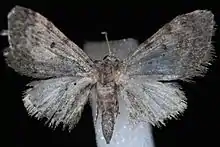| Eupithecia misturata | |
|---|---|
 | |
| Scientific classification | |
| Domain: | Eukaryota |
| Kingdom: | Animalia |
| Phylum: | Arthropoda |
| Class: | Insecta |
| Order: | Lepidoptera |
| Family: | Geometridae |
| Genus: | Eupithecia |
| Species: | E. misturata |
| Binomial name | |
| Eupithecia misturata | |
| Synonyms | |
| |
Eupithecia misturata is a moth in the family Geometridae first described by George Duryea Hulst in 1896. It is widely distributed in western North America.
The wingspan is about 16–18 mm. The forewings are pale gray, with a small black discal spot. Adults are on wing in summer.
The larvae feed on the foliage and flowers of various flowering trees and shrubs, including Holodiscus discolor, Ceanothus velutinus, Arctostaphylos and Quercus species.[3]
Subspecies
- Eupithecia misturata misturata (from southern California north to British Columbia and southern Alberta and east to the Rocky Mountains of Colorado, Utah and New Mexico)
- Eupithecia misturata delzurata Cassino & Swett 1922 (California)[4]
References
Wikimedia Commons has media related to Eupithecia misturata.
Wikispecies has information related to Eupithecia misturata.
- ↑ Yu, Dicky Sick Ki. "Eupithecia misturata (Hulst 1896)". Home of Ichneumonoidea. Taxapad. Archived from the original on March 25, 2016.
- ↑ "910326.00 – 7476 – Eupithecia misturata – (Hulst, 1896)". North American Moth Photographers Group. Mississippi State University. Retrieved March 3, 2019.
- ↑ "Eupithecia misturata [Geometridae]". Macromoths of Northwest Forests and Woodlands. United States Geological Survey. Archived from the original March 15, 2013.
- ↑ McDunnough, James H. (1949). "Revision of the North American species of the genus Eupithecia (Lepidoptera, Geometridae)" (PDF). Bulletin of the American Museum of Natural History. 93: 533–728.
This article is issued from Wikipedia. The text is licensed under Creative Commons - Attribution - Sharealike. Additional terms may apply for the media files.